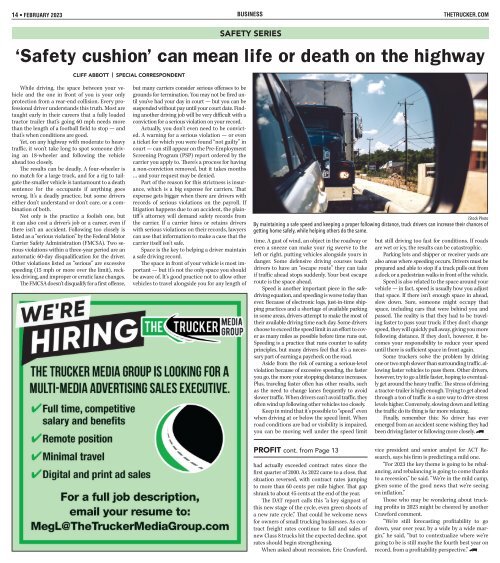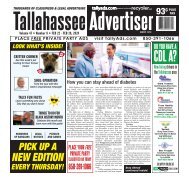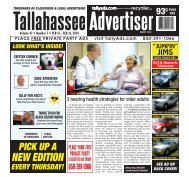020123_TT_AllPages
Create successful ePaper yourself
Turn your PDF publications into a flip-book with our unique Google optimized e-Paper software.
14 • FEBRUARY 2023 BUSINESS<br />
THETRUCKER.COM<br />
SAFETY SERIES<br />
‘Safety cushion’ can mean life or death on the highway<br />
CLIFF ABBO<strong>TT</strong> | SPECIAL CORRESPONDENT<br />
While driving, the space between your vehicle<br />
and the one in front of you is your only<br />
protection from a rear-end collision. Every professional<br />
driver understands this truth. Most are<br />
taught early in their careers that a fully loaded<br />
tractor trailer that’s going 60 mph needs more<br />
than the length of a football field to stop — and<br />
that’s when conditions are good.<br />
Yet, on any highway with moderate to heavy<br />
traffic, it won’t take long to spot someone driving<br />
an 18-wheeler and following the vehicle<br />
ahead too closely.<br />
The results can be deadly. A four-wheeler is<br />
no match for a large truck, and for a rig to tailgate<br />
the smaller vehicle is tantamount to a death<br />
sentence for the occupants if anything goes<br />
wrong. It’s a deadly practice, but some drivers<br />
either don’t understand or don’t care, or a combination<br />
of both.<br />
Not only is the practice a foolish one, but<br />
it can also cost a driver’s job or a career, even if<br />
there isn’t an accident. Following too closely is<br />
listed as a “serious violation” by the Federal Motor<br />
Carrier Safety Administration (FMCSA). Two serious<br />
violations within a three-year period are an<br />
automatic 60-day disqualification for the driver.<br />
Other violations listed as “serious” are excessive<br />
speeding (15 mph or more over the limit), reckless<br />
driving, and improper or erratic lane changes.<br />
The FMCSA doesn’t disqualify for a first offense,<br />
but many carriers consider serious offenses to be<br />
grounds for termination. You may not be fired until<br />
you’ve had your day in court — but you can be<br />
suspended without pay until your court date. Finding<br />
another driving job will be very difficult with a<br />
conviction for a serious violation on your record.<br />
Actually, you don’t even need to be convicted.<br />
A warning for a serious violation — or even<br />
a ticket for which you were found “not guilty” in<br />
court — can still appear on the Pre-Employment<br />
Screening Program (PSP) report ordered by the<br />
carrier you apply to. There’s a process for having<br />
a non-conviction removed, but it takes months<br />
… and your request may be denied.<br />
Part of the reason for this strictness is insurance,<br />
which is a big expense for carriers. That<br />
expense gets bigger when there are drivers with<br />
records of serious violations on the payroll. If<br />
litigation happens due to an accident, the plaintiff<br />
’s attorney will demand safety records from<br />
the carrier. If a carrier hires or retains drivers<br />
with serious violations on their records, lawyers<br />
can use that information to make a case that the<br />
carrier itself isn’t safe.<br />
Space is the key to helping a driver maintain<br />
a safe driving record.<br />
The space in front of your vehicle is most important<br />
— but it’s not the only space you should<br />
be aware of. It’s good practice not to allow other<br />
vehicles to travel alongside you for any length of<br />
iStock Photo<br />
By maintaining a safe speed and keeping a proper following distance, truck drivers can increase their chances of<br />
getting home safely, while helping others do the same.<br />
time. A gust of wind, an object in the roadway or<br />
even a sneeze can make your rig swerve to the<br />
left or right, putting vehicles alongside yours in<br />
danger. Some defensive driving courses teach<br />
drivers to have an “escape route” they can take<br />
if traffic ahead stops suddenly. Your best escape<br />
route is the space ahead.<br />
Speed is another important piece in the safedriving<br />
equation, and speeding is worse today than<br />
ever. Because of electronic logs, just-in-time shipping<br />
practices and a shortage of available parking<br />
in some areas, drivers attempt to make the most of<br />
their available driving time each day. Some drivers<br />
choose to exceed the speed limit in an effort to cover<br />
as many miles as possible before time runs out.<br />
Speeding is a practice that runs counter to safety<br />
principles, but many drivers feel that it’s a necessary<br />
part of earning a paycheck on the road.<br />
Aside from the risk of earning a serious-level<br />
violation because of excessive speeding, the faster<br />
you go, the more your stopping distance increases.<br />
Plus, traveling faster often has other results, such<br />
as the need to change lanes frequently to avoid<br />
slower traffic. When drivers can’t avoid traffic, they<br />
often wind up following other vehicles too closely.<br />
Keep in mind that it’s possible to “speed” even<br />
when driving at or below the speed limit. When<br />
road conditions are bad or visibility is impaired,<br />
you can be moving well under the speed limit<br />
but still driving too fast for conditions. If roads<br />
are wet or icy, the results can be catastrophic.<br />
Parking lots and shipper or receiver yards are<br />
also areas where speeding occurs. Drivers must be<br />
prepared and able to stop if a truck pulls out from<br />
a dock or a pedestrian walks in front of the vehicle.<br />
Speed is also related to the space around your<br />
vehicle — in fact, speed is usually how you adjust<br />
that space. If there isn’t enough space in ahead,<br />
slow down. Sure, someone might occupy that<br />
space, including cars that were behind you and<br />
passed. The reality is that they had to be traveling<br />
faster to pass your truck; if they don’t change<br />
speed, they will quickly pull away, giving you more<br />
following distance. If they don’t, however, it becomes<br />
your responsibility to reduce your speed<br />
until there is sufficient space in front again.<br />
Some truckers solve the problem by driving<br />
one or two mph slower than surrounding traffic, allowing<br />
faster vehicles to pass them. Other drivers,<br />
however, try to go a little faster, hoping to eventually<br />
get around the heavy traffic. The stress of driving<br />
a tractor-trailer is high enough. Trying to get ahead<br />
through a ton of traffic is a sure way to drive stress<br />
levels higher. Conversely, slowing down and letting<br />
the traffic do its thing is far more relaxing.<br />
Finally, remember this: No driver has ever<br />
emerged from an accident scene wishing they had<br />
been driving faster or following more closely. 8<br />
PROFIT cont. from Page 13<br />
had actually exceeded contract rates since the<br />
first quarter of 2000. As 2022 came to a close, that<br />
situation reversed, with contract rates jumping<br />
to more than 60 cents per mile higher. That gap<br />
shrank to about 45 cents at the end of the year.<br />
The DAT report calls this “a key signpost of<br />
this new stage of the cycle, even green shoots of<br />
a new rate cycle.” That could be welcome news<br />
for owners of small trucking businesses. As contract<br />
freight rates continue to fall and sales of<br />
new Class 8 trucks hit the expected decline, spot<br />
rates should begin strengthening.<br />
When asked about recession, Eric Crawford,<br />
vice president and senior analyst for ACT Research,<br />
says his firm is predicting a mild one.<br />
“For 2023 the key theme is going to be rebalancing,<br />
and rebalancing is going to come thanks<br />
to a recession,” he said. “We’re in the mild camp,<br />
given some of the good news that we’re seeing<br />
on inflation.”<br />
Those who may be wondering about trucking<br />
profits in 2023 might be cheered by another<br />
Crawford comment.<br />
“We’re still forecasting profitability to go<br />
down, year over year, by a wide by a wide margin,”<br />
he said, “but to contextualize where we’re<br />
going to be is still maybe the fourth best year on<br />
record, from a profitability perspective.” 8

















